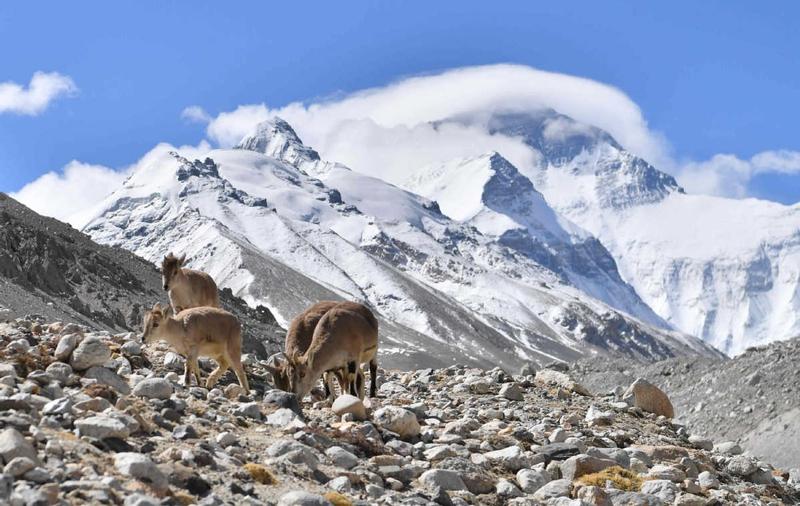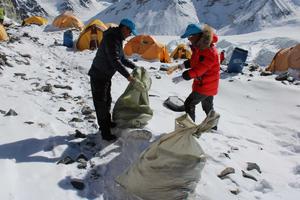Meticulous work carried out on world's highest peak
 Animals live wild on the slopes of Qomolangma. Work carried out on the mountain this year by Chinese team members will help protect the environment. (JIGME DORJE / XINHUA)
Animals live wild on the slopes of Qomolangma. Work carried out on the mountain this year by Chinese team members will help protect the environment. (JIGME DORJE / XINHUA)
The world's highest mountain officially became a little bit taller this month.
Qomolangma, known in the West as Mount Everest and which straddles the border between China and Nepal, now stands at 8,848.86 meters in the record books, according to an announcement made by the two countries on Dec 8.
With this year marking the 65th anniversary of the establishment of diplomatic relations between the two nations, the announcement was hailed as one of great significance.
President Xi Jinping said in a letter to his Nepalese counterpart, Bidya Devi Bhandari, that it marked a significant link between past and future, fully reflecting the high level of the evolving relationship between China and Nepal.
Xi said teams from the two countries overcame a series of difficulties, carried out important work and finally made a new determination of the mountain's height.
The spring climbing season on Qomolangma runs from late April to the end of May, as conditions at that time of year are favorable.
However, reaching the summit is difficult because of the thin air, and blizzards that can occur at any time.
Li Guopeng, captain of the Ministry of Natural Resources' First Geodetic Surveying Brigade, said, "We chose more than 70 core members who are physically strong and experienced climbers."
The Chinese team planned to complete preparatory work by the end of April, but did not have sufficient supplies of oxygen until April 28.
After much coordination work between departments, Li said they finally received enough oxygen, including eight bottles from Nepal.
On May 16, the team members began climbing the mountain in favorable conditions, before having to call off the attempt because of bad weather. A second attempt six days later also had to be abandoned due to the risk of avalanches, a major cause of death on Qomolangma.
On May 26, the survey team set out again and reached the summit at 11 am next day.
The team members stayed at the summit for a record 150 minutes, quickly setting up a surveying beacon and other equipment, including satellites and radar systems, to determine the mountain's height.
Li said their work effectively combined traditional measuring techniques and cutting-edge technology to ensure accuracy and precision.
A range of new technology developed in China was used to calibrate the mountain's height, including the BeiDou Satellite Navigation System for receiving and sending signals and data.
The team also used 5G communications technology, with domestic telecom giants China Mobile and Huawei providing advice during the ascent.
Li said: "Most team members left the Qomolangma region by June 18. The outdoor work took 111 days from the time the team arrived in the Tibet autonomous region on March 2."
Along with climbing and measuring, a considerable amount of work had to be completed on the ground.
"The preparations included data collection work that started as early as April last year," Li said.
 Members of the Chinese surveying team celebrate at base camp in the Tibet autonomous region after successfully measuring Qomolangma in May. (SUN FEI / XINHUA)
Members of the Chinese surveying team celebrate at base camp in the Tibet autonomous region after successfully measuring Qomolangma in May. (SUN FEI / XINHUA)
Difficult task
In May last year, a Nepalese surveying team reached the summit of Qomolangma to carry out measuring work.
This mission proved difficult, with a surveyor carrying a global positioning device and radar system to the summit losing the tip of a toe to frostbite, according to The Washington Post. The team also faced a shortage of oxygen on the descent.
After the teams from China and Nepal reached the summit, technicians from both nations carried out data processing work before agreeing on the mountain's new height.
Nepal had previously adopted an estimate of 8,848 meters made by India for the height in 1954, while China measured it at 8,844.43 meters in 2005. The difference in the two figures takes into account the snow cap.
Another problem was that China used the Yellow Sea as a sea-level base for the peak, but Nepal used the Indian Ocean.
Jiang Tao, associate researcher at the Chinese Academy of Surveying and Mapping, told Global Times: "In international cooperation, it is not appropriate to use either elevation benchmark. In line with international practice, we finally decided to use the parameters of the alternative Global Geodetic Observing System endorsed by the International Association of Geodesy."
Geodesy is the branch of mathematics dealing with the shape of the Earth or large portions of it.
Jiang said that after it was agreed to use the world standard, work progressed smoothly.
Santa Bir Lama, president of the Nepal Mountaineering Association, told USA Today, "This is a milestone in mountaineering history that will finally end debate over the height."
Buddhi Narayan Shrestha, former director-general of the Department of Survey Nepal, who acted as a senior adviser for the measuring project, told The Washington Post calculations by both countries had "synchronized sufficiently" to enable agreement on the new height.
"It couldn't have been more accurate than this," he added.
Rajiv Kumar Jha, a Nepalese professor at Xi'an Medical University in Shaanxi province, who has been visiting China for more than 20 years, said the relationship between the two countries "will rise across the Himalayas and reach a new height of over 8,848 meters".
The 41-year-old believes the announcement points to warming Sino-Nepalese ties against a backdrop of increasingly complex international relations and rising unilateralism during the pandemic.
Scientific exploration always comes with errors, but these can be minimized by international collaboration, he added.
Despite appearing to stand on extremely firm foundations, even Qomolangma shifts with time and tectonics-major events affecting the structure of the Earth's crust.
In 2015, a major earthquake struck the mountain and surrounding area, killing at least 8,700 people, damaging about 1 million structures in Nepal and triggering an avalanche on Qomolangma that claimed 19 lives at base camp.
The tragedy also triggered debate over the mountain's height and concern that it may have shrunk.
 China's Tibet Sports Bureau has trained and hired locals as conservation workers to clear waste from the mountain. (PHOTO / XINHUA)
China's Tibet Sports Bureau has trained and hired locals as conservation workers to clear waste from the mountain. (PHOTO / XINHUA)
Over the years, a number of heights have been allocated to Qomolangma. Measuring the mountain can be traced to the mid-19th century, when a survey team from India put its height at 8,840.07 meters. Since then, many countries have submitted their own measurements.
In 1975, Chinese surveyors determined the height to be 8,848.13 meters, while 30 years later, a team from the country scaled the mountain and amended the height to 8,844.43 meters.
The measuring work carried out on Qomolangma this year, which also assessed snow depth, weather conditions and wind speed, will help glacier monitoring and environmental protection work.
First scaled in 1953, Qomolangma has become a target for international climbers, with hundreds arriving on its slopes in spring every year.
However, they leave behind a vast amount of rubbish and human waste, which has resulted in the mountain being tagged "the world's highest garbage dump".
War on waste
China and Nepal have been working hard to rid the mountain of waste.
China's Tibet Sports Bureau has trained and hired locals as conservation workers to clear the rubbish. According to official data, more than 8.4 metric tons of waste has been removed from heights above 5,200 meters.
Last year, the Ministry of Finance promised to allocate 4 million yuan (US$595,000) to the bureau for the cleanup work.
The Mount Qomolangma National Nature Reserve banned tourists from entering its core zone early last year. The reserve, which covers 33,800 square kilometers and extends from a height of more than 1,400 meters to the mountain's summit, was established in 1988 to better preserve the environment.
Similar steps have been taken by Nepal, which in 2014 passed a regulation requiring every climber to take at least 17 pounds (7.7 kilograms) of waste off the mountain-the average amount left behind by each mountaineer, USA Today reported.
Meanwhile, studies have shown that glaciers in the Qomolangma region, as in most parts of the Himalayas, are melting rapidly and thinning because of climate change.
Glaciers basically act as water towers. They store winter snowfall, which melts in spring and summer to replenish rivers, providing a steady supply of water for humans and ecosystems.
Shrinking glaciers increase water flows in rivers. If temperatures rise as predicted and the glaciers continue to melt, the flows could trigger devastating floods, displace millions of people and lead to huge economic losses.
Flows will decrease if combined with overuse of fresh water, but this will have a huge impact not only on local people but on global ecosystems.
Jha, from Xi'an Medical University, said: "Water is so important to us. People cannot live without drinking water. In addition, water is a source of clean energy and can generate electricity. That's why we should protect the environment (on Qomolangma)."
He added that the announcement by China and Nepal on the mountain's height will enable the two countries to cooperate more on conservation work on Qomolangma, "our shared treasure and home".
Xin Wen contributed to this story.


